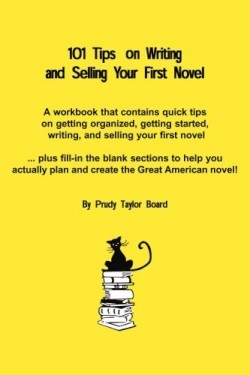101 Tips on Writing and Selling Your First Novel
For anyone who has a secret desire to write a novel but is intimidated by the enormity of the endeavor, this book will help. Descriptively subtitled Quick, common-sense tips on getting organized, getting started, and writing your first novel, plus pointers on selling it, and fill-in the blanks to help you actually plan and create the Great American Novel, the book is written in an easy, conversational style with enough humor to make the learning enjoyable. The author takes a budding writer through the whole process, from writing the first word to marketing the finished product.
Board encourages prospective writers to develop a good sense of humor to deal with rejection because there’s a lot of it on the road to publication and rejection goes down easier with a laugh. She follows that advice with this poem, which should be printed and taped to the computer screen of every writer:
“And keep writing
Always
That’s what successful, professional writers do, you know.
They write.
Day in and day out, they write.
Headaches, backaches, heartaches, stomachaches, they write.”
The book covers the standard areas of the craft: outlining, plotting, character development, and dialogue. It also has some fresh and unusual tips, like going to the office supply store and stocking up on pens, paper, ink cartridges, and anything else a writer might need. While that may seem like a silly suggestion, Taylor-Board makes the point that stocking up first helps a writer prepare psychologically. It also keeps him or her at home writing instead of using the excuse of needing a notebook to run out to the store.
Finding reasons not to write is the bane of many writers, even those with years of publication experience. Board’s career as an author and editor spans twenty-five years. In addition to having published twelve books, she’s worked as a reporter, writer, and editor for television, radio stations, and a newspaper, so she knows the daily challenge of self-discipline. “An important part of getting a novel written,” she says, “is learning to abort or short-circuit non-productive behavior.”
It’s said that creativity is not neat, so some people might find the book a little extreme on organization—setting up storage boxes for research materials, binders for plotting and character notes, notebooks for outlines. However, the author makes a valid point for all the detail, especially for the first-time novelist: “Organization and an outline give you an incredible sense of security.”
Reviewed by
Maryann Miller
Disclosure: This article is not an endorsement, but a review. The publisher of this book provided free copies of the book to have their book reviewed by a professional reviewer. No fee was paid by the publisher for this review. Foreword Reviews only recommends books that we love. Foreword Magazine, Inc. is disclosing this in accordance with the Federal Trade Commission’s 16 CFR, Part 255.

